Lemon is a widely cultivated crop in many regions of the world due to its commercial value and versatility in cooking and industry. However, like any other crop, lemon is subject to various diseases that can affect its growth, yield, and fruit quality. These diseases can be caused by bacteria, fungi, viruses, and other pathogens that attack the plant at different stages of its development.
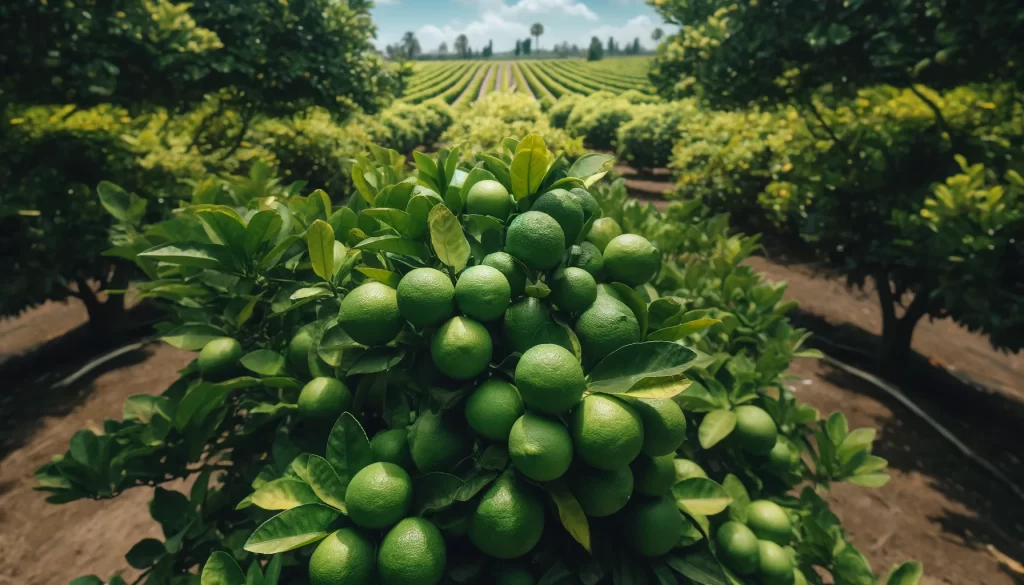
In this article, we will explore some of the main diseases that affect lemon cultivation, their characteristic symptoms, and how they can be combated. From the devastating bacteria associated with Huanglongbing (HLB) to the fungi causing anthracnose and root rot, we will address the integrated pest and disease management strategies that producers can implement to protect their crops and maintain the health of their plantations.
Main Diseases of Lemon Cultivation
Huanglongbing (HLB) or Yellow Dragon Disease:
Huanglongbing (HLB), also known as yellow dragon disease, is one of the most devastating diseases affecting citrus crops, including lemon. This disease is caused by a bacterium of the genus Candidatus Liberibacter, primarily transmitted by certain species of sap-sucking insects, such as the Asian citrus psyllid.

The bacterium infects the phloem of the plant, the vascular tissue that transports nutrients and water throughout the plant. Once infected, the plant experiences a series of symptoms including leaf yellowing (hence the term “yellow” in the disease’s name), reduced fruit size and quality, stunted growth, and eventual decline and death of the plant. Symptoms can vary depending on the citrus variety and environmental conditions, but mottled yellow blotches on the leaves are a characteristic sign.
This disease poses a significant threat to the citrus industry worldwide due to its rapid spread and ability to cause substantial economic losses. It not only affects fruit production but can also lead to the destruction of nurseries and entire plantations if not adequately controlled.
Combating Huanglongbing is a considerable challenge due to the lack of effective cures once a plant is infected. The primary strategy for managing this disease involves the prevention and control of vector insects, as well as the rapid removal of infected plants to prevent the spread of the bacterium to nearby plants.
Integrated pest management methods that include the application of selective insecticides, the removal of infected plants, the use of resistant varieties, and the implementation of proper cultural practices are crucial in the fight against HLB. Additionally, ongoing research on early detection methods and innovative control strategies remains a priority in the scientific and agricultural communities to combat this disease and protect the long-term viability of the citrus industry.
Anthracnose
Anthracnose is a fungal disease that affects a wide variety of crops, including lemon. It is caused by fungi of the genus Colletotrichum, with Colletotrichum gloeosporioides and Colletotrichum acutatum being the most common species affecting citrus, including lemon.
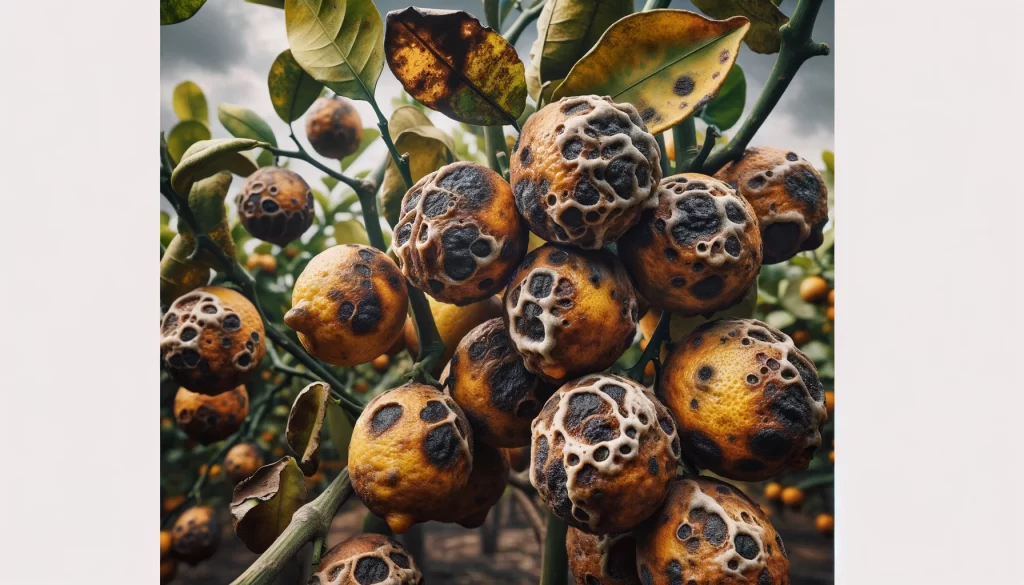
Symptoms of anthracnose on lemon usually manifest initially as small light brown spots on leaves, stems, flowers, and fruits. These spots can enlarge over time and develop a dark center surrounded by a lighter ring, giving them a characteristic “bull’s-eye” appearance. On fruits, anthracnose lesions can cause them to rot, deform, or drop prematurely, resulting in significant production losses.
Anthracnose thrives in conditions of high humidity and warm temperatures, which favor its spread and development. The disease can be transmitted through spores that spread by water splashes, wind, agricultural tools, and handling of infected plants.
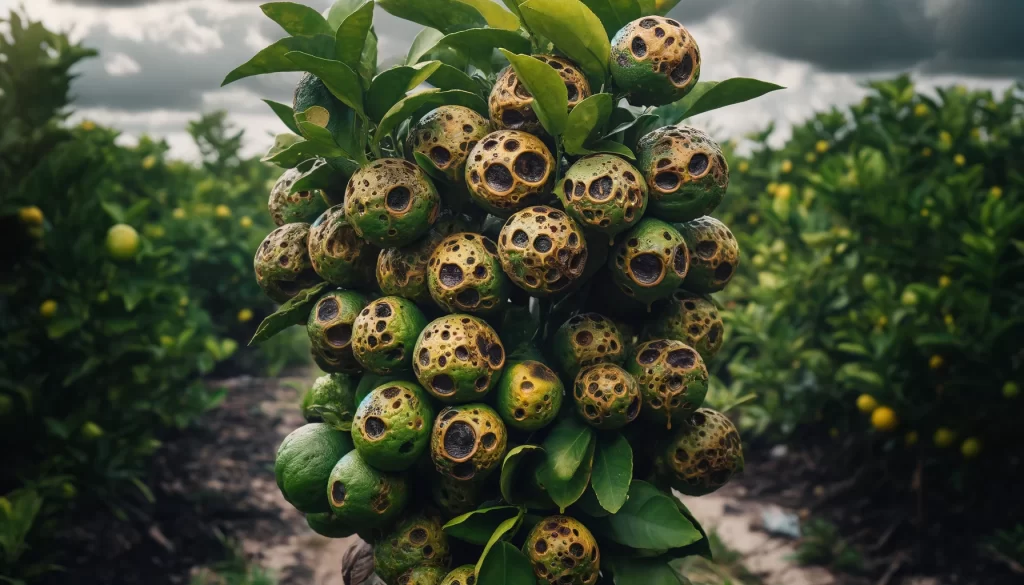
To control anthracnose in lemon cultivation, several strategies can be implemented:
- Environmental management: Reducing humidity in the environment through proper irrigation practices and improving air circulation around the plants can help decrease the spread of the disease.
- Sanitary pruning: Removing infected branches and keeping the plant well-pruned can help reduce the spread of the disease by eliminating infected plant material.
- Chemical control: The use of fungicides can be effective in preventing and controlling anthracnose in lemon cultivation. It is important to follow the manufacturer’s recommendations and apply fungicides at the appropriate time for best results.
- Resistant varieties: Resistant lemon varieties are being developed as a long-term control measure. Selecting varieties that are less susceptible to the disease can help reduce its impact on production.
- Crop rotation: Avoiding planting lemons in areas where anthracnose has been previously detected can help prevent the buildup of fungal spores in the soil and reduce the risk of infection in future crops.
The combination of these integrated pest and disease management strategies can help minimize the impact of anthracnose on lemon cultivation and maintain the health of plantations in the long term.
Alternaria alternata
Alternaria alternata is a fungus that causes the disease known as leaf spot in lemon cultivation. This disease is one of the most common and problematic in citrus crops, as it can affect leaf health and reduce fruit yield and quality.
Typical symptoms of Alternaria alternata infection in lemon include the appearance of brown to black spots on the leaves. These spots can be circular or irregular in shape and are often surrounded by a yellow halo. As the disease progresses, the lesions can merge, causing leaf necrosis and, in severe cases, premature defoliation.
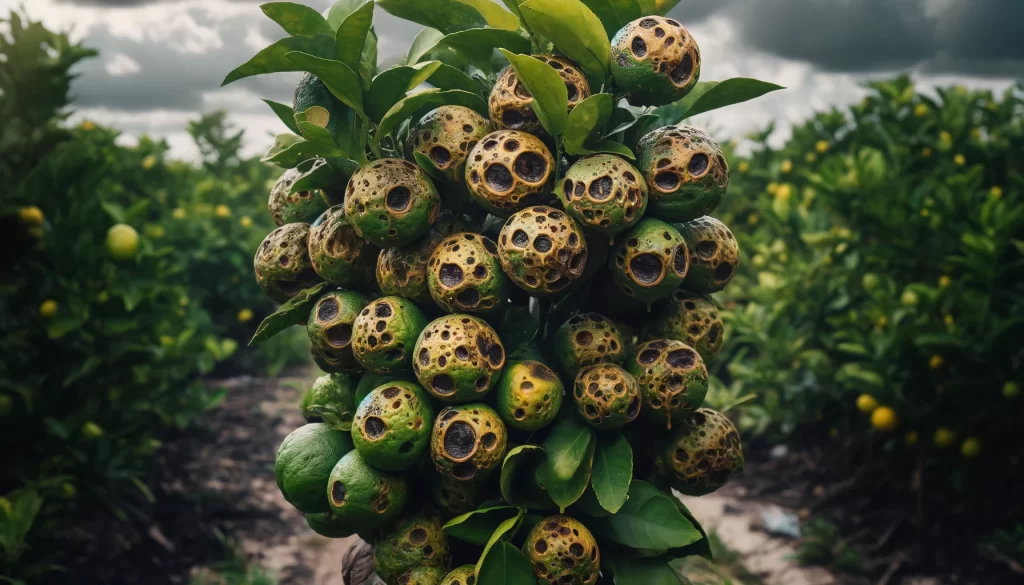
The disease spreads primarily through spores that are disseminated by wind or water, especially in conditions of high humidity and warm temperatures. The spores can survive on plant debris and in the soil, facilitating their spread from one growing season to another.
To control Alternaria alternata in lemon cultivation, several management measures can be followed:
- Cultural practices: Promoting air circulation around the plants through proper pruning and adequate spacing between rows can help reduce humidity in the plant canopy and decrease the spread of the disease.
- Irrigation: Avoiding overhead irrigation and keeping the foliage dry overnight can help reduce disease incidence by limiting favorable conditions for fungal growth.
- Chemical control: The use of specific fungicides for the control of Alternaria can be effective in preventing infection and stopping its spread. It is important to apply fungicides preventively and follow the manufacturer’s recommendations.
- Crop rotation: Avoiding planting lemons in the same area for prolonged periods can help reduce the buildup of fungal spores in the soil and decrease the risk of infection in future crops.
- Removal of plant debris: Removing infected crop residues and keeping the growing area clean can help reduce the presence of fungal spores and prevent reinfection in subsequent growing seasons.
By implementing these integrated pest and disease management strategies, lemon growers can reduce the impact of Alternaria alternata on their plantations and maintain the health and productivity of their crops.
Penicillium rots
Penicillium rots is a fungal disease that affects citrus fruits, including lemon. This disease is caused by fungi of the genus Penicillium, specifically Penicillium digitatum and Penicillium italicum, and manifests as fruit rot, which can result in significant production and quality losses of lemons.

Symptoms of Penicillium rots infection on lemon usually begin as small wet and soft spots on the fruit surface. These spots can be blue-green or white in color, and over time they expand and can cover large areas of the fruit. As the disease progresses, the fruit becomes soft and begins to decompose, emitting a characteristic unpleasant odor.
The disease spreads primarily through spores that can be dispersed by air, rainwater, contaminated agricultural tools, and infected fruits. Penicillium spores can penetrate the skin of lemons through small wounds, cuts, or lesions, facilitating infection and the spread of the fungus inside the fruit.
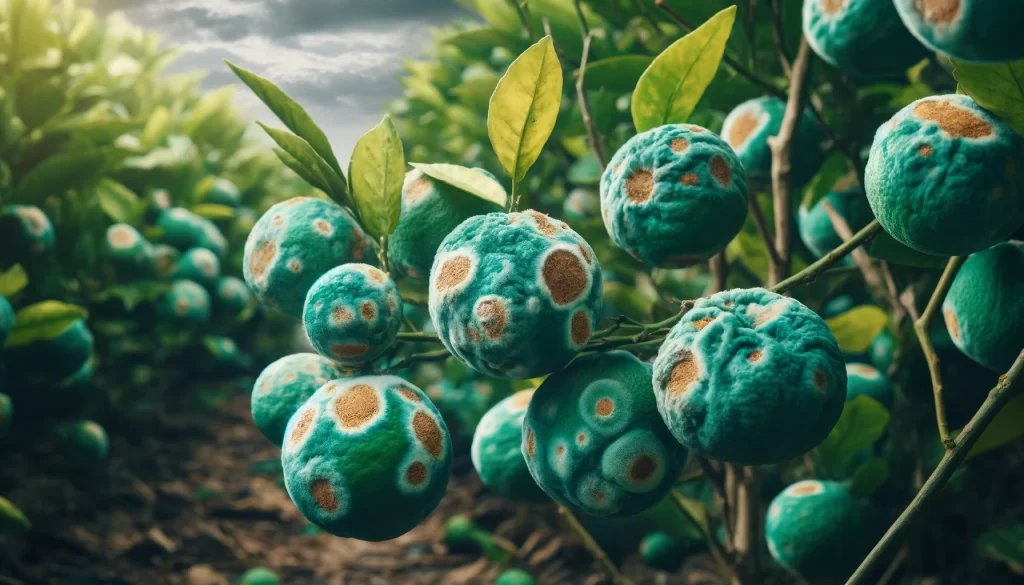
To control Penicillium rots in lemon cultivation, several management strategies can be followed:
- Post-harvest management practices: It is important to harvest lemons carefully to avoid skin damage that can facilitate the entry of Penicillium spores. Additionally, lemons should be handled and stored carefully to avoid injuries that can favor disease development.
- Proper storage: Keeping lemons under proper storage conditions, such as cool temperatures and low relative humidity, can help reduce the incidence and development of Penicillium rots. High humidity and warm temperatures that favor fungal growth should be avoided.
- Fungicide treatments: The application of specific fungicides for the control of Penicillium rots can be effective in preventing infection and stopping its spread. It is important to apply fungicides according to the manufacturer’s recommendations and at the appropriate time for best results.
- Removal of infected fruits: Removing and destroying infected fruits can help reduce the presence of Penicillium spores in the orchard and prevent the spread of the disease to other healthy fruits.
By implementing these integrated pest and disease management strategies, lemon growers can reduce the impact of Penicillium rots on their plantations and maintain the quality and productivity of their crops.
Phytophthora
Phytophthora is a genus of oomycete fungi that includes many species capable of causing diseases in a wide variety of plants, including citrus such as lemon. The most common disease caused by Phytophthora in lemon cultivation is root rot, known as phytophthora root rot.

Root rot caused by Phytophthora is a serious problem in citrus as it affects the plant’s root system, interfering with its ability to absorb water and nutrients. This can lead to symptoms such as leaf yellowing, wilting, premature leaf and branch drop, and eventually, plant death.
The disease spreads primarily through spores that can move in the soil, contaminated irrigation water, and agricultural tools. Phytophthora spores can survive in the soil for prolonged periods and can infect plant roots when conditions are favorable, such as wet soils and warm temperatures.
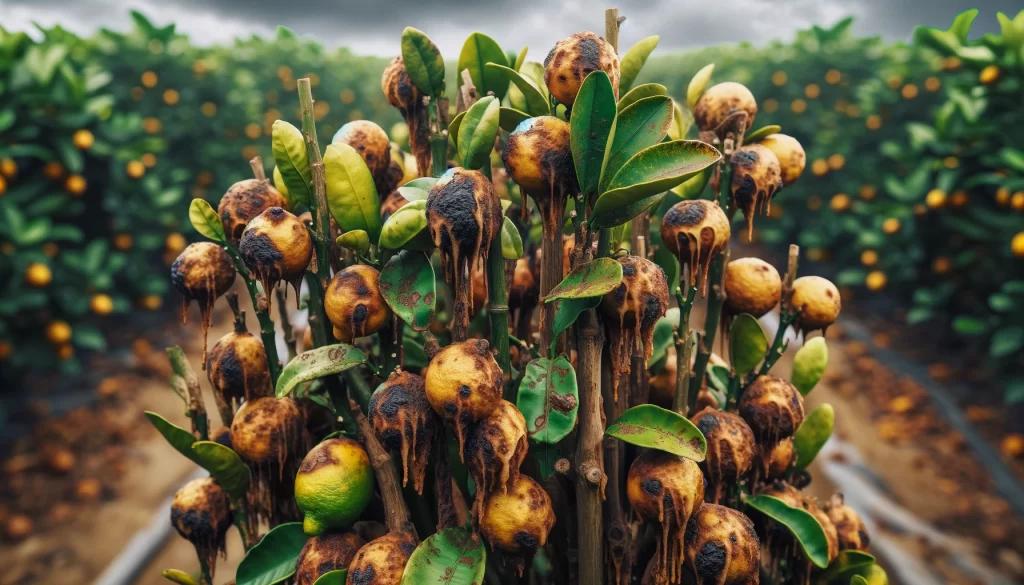
To control Phytophthora in lemon cultivation, several management strategies can be followed:
- Improving soil drainage: Phytophthora root rot is favored by poorly drained and waterlogged soils. Improving soil drainage through leveling, the use of raised beds, or the installation of drainage systems can help reduce disease incidence.
- Irrigation control: Avoiding over-irrigation and ensuring the soil dries out between waterings can help reduce soil moisture and prevent the spread of Phytophthora. Drip irrigation may be preferable to overhead irrigation as it provides water directly to the roots without wetting the foliage and surrounding soil.
- Crop rotation: Avoiding planting lemons in the same area for prolonged periods can help reduce the buildup of Phytophthora spores in the soil and decrease the risk of infection in future crops.
- Fungicide treatments: The application of specific fungicides for the control of Phytophthora can be effective in preventing infection and stopping its spread. It is important to apply fungicides according to the manufacturer’s recommendations and at the appropriate time for best results.
- Selection of resistant varieties: Some lemon varieties may have some degree of resistance to Phytophthora. Selecting varieties that are less susceptible to the disease can help reduce its impact on production.
By implementing these integrated pest and disease management strategies, lemon growers can reduce the impact of Phytophthora on their plantations and maintain the health and productivity of their crops.
Lemon Mosaic Virus
Lemon mosaic virus is a viral disease that affects lemon and other citrus crops. This virus belongs to the family Bromoviridae and can cause various symptoms in plants, including spots and deformations on the leaves, reduced growth, mosaics or irregular coloration patterns on the leaves, and stunting of the plant.
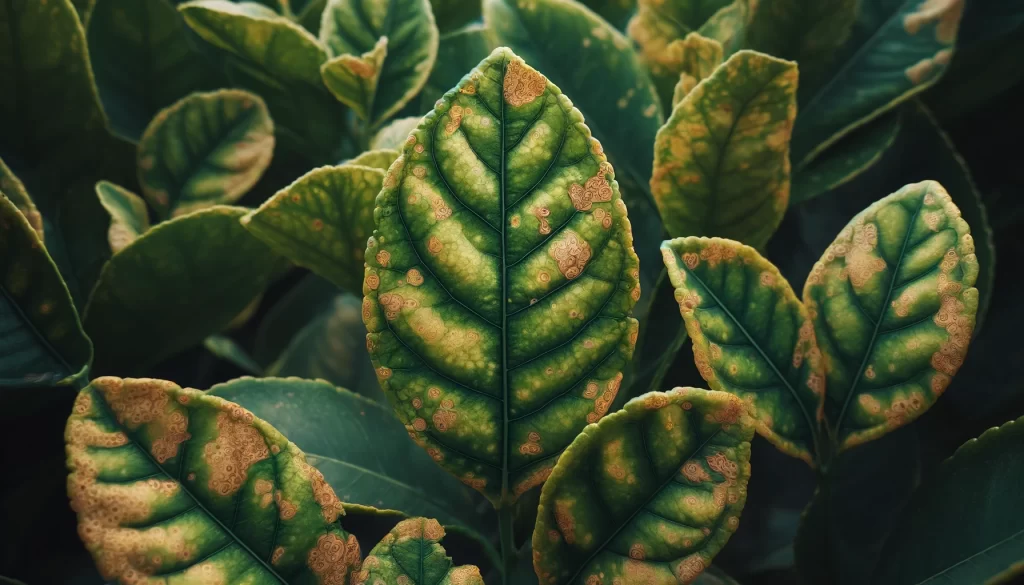
Lemon mosaic virus is primarily transmitted through grafting, as well as by vector insects such as aphids and thrips. Once a plant is infected, the virus spreads throughout the plant, affecting its ability to perform vital functions such as photosynthesis and nutrient transport.
Symptoms of lemon mosaic virus can vary depending on the virus strain, lemon variety, and environmental conditions. In some cases, symptoms can be mild and barely noticeable, while in others, they can be more severe and cause significant damage to the plant and fruit production.
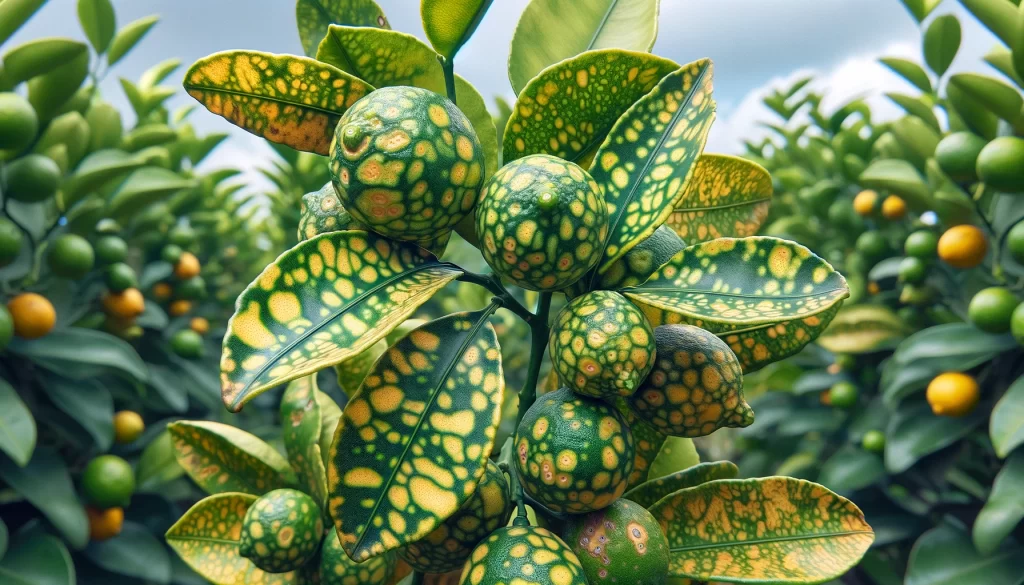
To control lemon mosaic virus and prevent its spread in crops, several management measures can be followed:
- Control of vector insects: Reducing the population of vector insects, such as aphids and thrips, can help prevent the transmission of the virus between plants. This can be achieved through the use of insecticides, weed removal, and the implementation of integrated pest management practices.
- Selection of virus-free plant material: Using certified virus-free plant material for propagation can help prevent the introduction and spread of the virus in new growing areas.
- Removal of infected plants: Identifying and removing infected plants can help reduce the spread of the virus in the orchard. It is important to properly dispose of and destroy infected plants to prevent reintroduction of the virus into the crop.
- Improving management practices: Maintaining good overall crop management, including proper irrigation, fertilization, and weed control practices, can help strengthen plant health and reduce susceptibility to the virus.
- Research and development of resistant varieties: Continuing research and development of lemon varieties that are resistant to lemon mosaic virus can be an important strategy for long-term disease control.
By implementing these integrated pest and disease management measures, lemon growers can help reduce the incidence and impact of lemon mosaic virus on their crops, thus protecting the health and productivity of their plantations.
 AgronoBlog – Agriculture Blog
AgronoBlog – Agriculture Blog 
